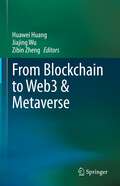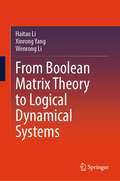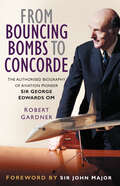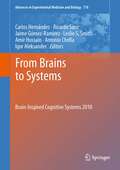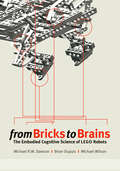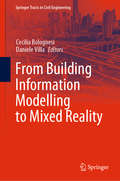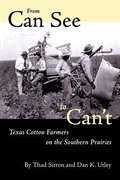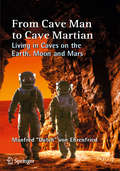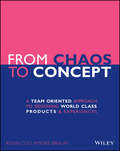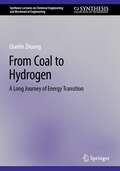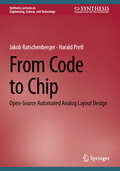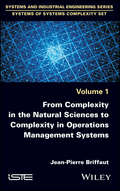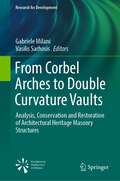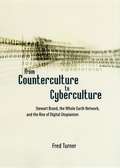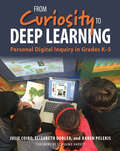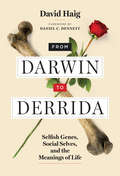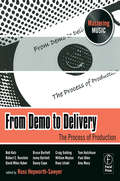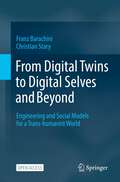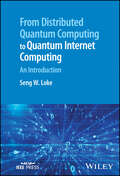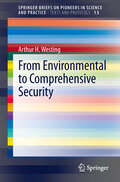- Table View
- List View
From Blockchain to Web3 & Metaverse
by Zibin Zheng Jiajing Wu Huawei HuangThe Metaverse seamlessly integrates the real world with the virtual world and allows avatars to engage in a broad range of activities including entertainment, social networking, and trading. In this book, we dive into the Metaverse by discussing how blockchains connect various Metaverse components, digital currencies, and blockchain-empowered applications in the virtual world. On the other hand, Web3 has also attracted considerable attention due to its uniquely decentralized characteristics. The digital economy, currently undergoing a rapid development, is a critical driver to highly efficient societies. It is imperative that we investigate how to use Web3 technologies to address the critical concerns encountered during the development of the digital economy by fully exploring Web3. In this book, we also share insights into the Web3-based ecosystem in the Metaverse; topics of interest include decentralized finance, digital assets, the asset-trading market, etc. Unlike most works on the subject, this book mainly concentrates on insights and discussions regarding blockchain, the Metaverse and Web3. In other words, it focuses on using blockchain technologies to enable an ecosystem for both the Metaverse and Web3. Topics addressed include blockchain fundamentals, smart contracts, value circulation in the Metaverse, the connection between the Metaverse and Web3, the establishment of the Metaverse on the basis of blockchain technologies, decentralized autonomous organization, decentralized storage, digital economy, Web3-based economic systems for the Metaverse, etc. This book will be a valuable resource for students, researchers, engineers, and policymakers working in various areas related to blockchain, the Metaverse and Web3. We hope that it will also inspire readers from academia and industry alike, and ultimately help them create a truly open, fair, and rational ecosystem for the Metaverse and Web3.
From Boolean Matrix Theory to Logical Dynamical Systems
by Xinrong Yang Haitao Li Wenrong LiThis book offers a systematic platform for the theory of Boolean matrix and its application in logical dynamical systems. As a special kind of non-negative matrix, Boolean matrix has wide applications in graph theory, discrete-event system, game theory, clustering analysis, and so on. Due to the special operations between Boolean matrices, there exist some special mathematical properties for Boolean polynomial and Boolean vector space, which necessitate a general theory of Boolean matrix. Furthermore, logical dynamical systems have received recent attention from systems biology, information security, artificial intelligence, etc. The development of logical dynamical systems needs the mathematical foundation of Boolean matrix and logical matrix. Therefore, it is necessary to explore the relation between Boolean matrix theory and logical dynamical systems. To our best knowledge, there are no published books available on both Boolean matrix theory and logical dynamical systems. This book aims to provide some recent insightful results to meet this gap. It can serve as a textbook for scholars and students of mathematics, cybernetics, biology and artificial intelligence. Especially, the book is an important reference for readers who are interested in Boolean matrix theory and logical dynamical systems.
From Bouncing Bombs to Concorde: The Authorised Biography of Aviation Pioneer Sir George Edwards OM
by John Major Robert GardnerGeorge Edwards' name is synonymous with the Vickers Viscount, the world's first turboprop airliner; the controversial TSR2 project and the legendary Anglo-French Concorde. During the Second World War, it was Edwards who made the Dam Busters' bouncing bombs bounce.
From Brains to Systems
by Leslie S. Smith Igor Aleksander Amir Hussain Antonio Chella Ricardo Sanz Carlos Hernández Jaime Gómez RamirezBrain Inspired Cognitive Systems - BICS 2010 aims to bring together leading scientists and engineers who use analytic and synthetic methods both to understand the astonishing processing properties of biological systems and specifically of the brain, and to exploit such knowledge to advance engineering methods to build artificial systems with higher levels of cognitive competence. BICS is a meeting point of brain scientists and cognitive systems engineers where cross-domain ideas are fostered in the hope of getting emerging insights on the nature, operation and extractable capabilities of brains. This multiple approach is necessary because the progressively more accurate data about the brain is producing a growing need of a quantitative understanding and an associated capacity to manipulate this data and translate it into engineering applications rooted in sound theories. BICS 2010 is intended for both researchers that aim to build brain inspired systems with higher cognitive competences, and for life scientists who use and develop mathematical and engineering approaches for a better understanding of complex biological systems like the brain. Four major interlaced focal symposia are planned for this conference and these are organized into patterns that encourage cross-fertilization across the symposia topics. This emphasizes the role of BICS as a major meeting point for researchers and practitioners in the areas of biological and artificial cognitive systems. Debates across disciplines will enrich researchers with complementary perspectives from diverse scientific fields. BICS 2010 will take place July 14-16, 2010, in Madrid, Spain.
From Bricks to Brains
by Michael Wilson Michael R.W. Dawson Brian DupuisFrom Bricks to Brains introduces embodied cognitive science, and illustrates its foundational ideas through the construction and observation of LEGO Mindstorms robots. Discussing the characteristics that distinguish embodied cognitive science from classical cognitive science, From Bricks to Brains places a renewed emphasis on sensing and acting, the importance of embodiment, the exploration of distributed notions of control, and the development of theories by synthesizing simple systems and exploring their behaviour. Numerous examples are used to illustrate a key theme: the importance of an agent's environment. Even simple agents, such as LEGO robots, are capable of exhibiting complex behaviour when they can sense and affect the world around them.
From Building Information Modelling to Mixed Reality (Springer Tracts in Civil Engineering)
by Daniele Villa Cecilia BolognesiThis book reports on the latest advances in using BIM modelling to achieve the semantic enrichment of objects, allowing them to be used both as multidimensional databases – as comprehensive sources of information for finalizing various types of documentation in the building industry – and as modelling tools for the construction of virtual environments. Having advanced to a new stage of development, BIM modelling is now being applied in a range of increasingly complex contexts, and for various new purposes. This book examines the role that virtual reality and related technologies such as AI and IoT can play in preserving and disseminating our cultural heritage and built environment.
From Can See to Can't
by Thad SittonCotton farming was the only way of life that many Texans knew from the days of Austin's Colony up until World War II. For those who worked the land, it was a dawn-till-dark, "can see to can't," process that required not only a wide range of specialized skills but also a willingness to gamble on forces often beyond a farmer's control--weather, insects, plant diseases, and the cotton market. This groundbreaking book offers an insider's view of Texas cotton farming in the late 1920s. Drawing on the memories of farmers and their descendants, many of whom are quoted here, the authors trace a year in the life of south central Texas cotton farms. From breaking ground to planting, cultivating, and harvesting, they describe the typical tasks of farm families--as well as their houses, food, and clothing; the farm animals they depended on; their communities; and the holidays, activities, and observances that offered the farmers respite from hard work. Although cotton farming still goes on in Texas,the lifeways described here have nearly vanished as the state has become highly urbanized. Thus, this book preserves a fascinating record of an important part of Texas' rural heritage.
From Cave Art to Hubble: A History of Astronomical Record Keeping (Astronomers' Universe)
by Jonathan PowellSince ancient times, humans have been engaged in a continual quest to find meaning in and make sense of sights and events in the night sky. Cultures spread around the world recorded their earliest efforts in artwork made directly on the natural landscapes around them, and from there they developed more and more sophisticated techniques for observing and documenting astronomy.This book brings readers on an astronomical journey through the ages, offering a history of how our species has recorded and interpreted the night sky over time. From cave art to parchment scribe to modern X-ray mapping of the sky, it chronicles the ever-quickening development of tools that informed and at times entirely toppled our understanding of the natural world.Our documentation and recording techniques formed the bedrock for increasingly complex forays into astronomy and celestial mechanics, which are addressed within these chapters. Additionally, the book explores how nature itself has recorded the skies in its own way, which can be unraveled through ongoing geological and archaeological studies. This tale of human discovery and ingenuity over the ages will appeal to anybody interested in the field of astronomy and its rich cultural history.
From Cave Man to Cave Martian: Living in Caves on the Earth, Moon and Mars (Springer Praxis Books)
by Manfred "Dutch" von EhrenfriedThis book explores the practicality of using the existing subsurface geology on the Moon and Mars for protection against radiation, thermal extremes, micrometeorites and dust storms rather than building surface habitats at great expense at least for those first few missions. It encourages NASA to plan a precursor mission using this concept and employ a “Short Stay” Opposition Class mission to Mars as the first mission rather than the “Long Stay” concept requiring a mission that is too long, too dangerous and too costly for man’s first missions to Mars.Included in these pages is a short history on the uses of caves by early humans over great periods of time. It then describes the ongoing efforts to research caves, pits, tunnels, lava tubes, skylights and the associated technologies that pertain to potential lunar and Mars exploration and habitation. It describes evidence for existing caves and lava tubes on both the Moon and Mars. The work of noted scientists, technologists and roboticists are referenced and described. This ongoing work is moreextensive than one would think and is directly applicable to longer term habitation and exploration of the Moon and Mars. Emphasis is also given to the operational aspects of working and living in lunar and Martian caves and lava tubes.
From Chaos to Concept: A Team Oriented Approach to Designing World Class Products and Experiences
by Kevin Collamore BraunThis book is written for product design, software development, graphic design, and UX professionals with a focus on creating measurably better user experiences. If you want to design solutions to meet business goals and delight your users, you can look to this resource which covers the following areas: Creating and documenting goals, strategies, objectives, and tactics Defining or refining personas based on your measurable objectives (OKRs) Creating and iterating on scenarios based your prioritized personas A team approach to defining the product and roadmap to address critical use cases Team based divergent ideation and solution exploration Team based convergent solution definition Wireframing potential solutions for rapid research and iteration Using quantitative and qualitative methods to understand usage and test with users Exploring approaches to taxonomy and information architecture Using psychology and human factors to drive your design decisions Developing performant, accessible, maintainable experiences Using analytics to measure the results and inform the next iteration How this process differs based on the size of the company or team that is employing it
From Coal to Hydrogen: A Long Journey of Energy Transition (Synthesis Lectures on Chemical Engineering and Biochemical Engineering)
by Qianlin ZhuangThe book tells the story of the coal gasification technology from its early days 230 years ago to the present. Before the end of WWII, gasification had been extensively used to produce both fuel gas and gaseous feedstock from coal. But things have changed when natural gas became readily available, and coal gasification received little attention, especially in recent years when the trend is to move away from fossil energy. Compared to conventional coal combustion, gasification-based processes for power production typically result in much lower emissions of pollutants. So, coal gasification technology became relevant again during the transition of energy production to cleaner sources, in an effort to fight climate change. Taking another look at gasification technology to better understand its potential benefits including carbon capture and management and use the process, seems to make sense during the challenging time of the transition of energy production. Professionalsand policy makers in the energy field will benefit from this writing.
From Code to Chip: Open-Source Automated Analog Layout Design (Synthesis Lectures on Engineering, Science, and Technology)
by Jakob Ratschenberger Harald PretlThis book shows how the layout of an analog circuit can be automatically generated in a fully open-source way. Based on an exemplary design flow, it introduces and explains the necessary steps for transforming a SPICE netlist into a layout, which can be inspected by the open-source layout editor Magic VLSI. This is done by using the industry’s first open-source process design kit SKY130. Furthermore, the implementation of the design flow in the programming language Python is available as open-source on GitHub.
From Complexity in the Natural Sciences to Complexity in Operations Management Systems
by Jean-Pierre BriffautAlthough complexity makes up the very fabric of our daily lives and has been more or less addressed in a wide variety of knowledge fields, the approaches developed in the Natural Sciences and the results obtained over the past century have not yet permeated Management Sciences very much. The main features of the phenomena that the Natural Sciences deal with are: non-linear behavior, self-organization and chaos. They are analyzed with the framing of what is called “systems thinking”, popularized by the mindset pertaining to cybernetics. All pioneers in systems thinking either had direct or indirect connections with Biology, which is the discipline considered complex par excellence by the public. When applying these concepts to Operations Management Systems and modeling organizations by BDI (Beliefs, Desires, Intentions) agents, the lack of predictability in the conduct of change management that is prone to bifurcations (tipping points) in terms of organizational structures and in forecasting future activities, reveals them to be ingrained in the interplay of complexity and chaos.
From Complexity to Simplicity
by Simon Collinson Melvin JayComplexity is slowing companies down, costing them on average 10% of their profits. Based on cutting-edge research, this practical 'how to' guide will show businesses how to remove complexity to boost profits and morale.
From Corbel Arches to Double Curvature Vaults: Analysis, Conservation and Restoration of Architectural Heritage Masonry Structures (Research for Development)
by Gabriele Milani Vasilis SarhosisThe book focuses on all typological aspects of arches and vaults within the heritage of design and construction, while bringing attention to new “green” materials, promoting a circular economy informed by limitations caused by global warming. The multidisciplinary approach involves several different competences in architecture, structural engineering, conservation and restoration, geomatics, BIM, building engineering, the technology and history of construction, graphical methods of assessment, and innovative design that utilizes non-polluting materials. After an overview of the technical and aesthetic advantages of masonry vaults, there is a review of the most up-to-date trends in historic preservation. Classic methods of static assessment and innovative building technologies are detailed. Surveying methods and data acquisition are discussed, particularly laser scanning technology and its applications in heritage masonry curved structures. Next comes the experimental static and dymanic behavior of masonry vaults, followed by a critical revision of Distinct Element innovative computerized Methods. An explanation as to how to pass from classic stability analysis to an adaptive Finite Element Method limit analysis procedure is offered. Reinterpretation of the past is then undertaken, with an eye towards emphasizing sustainability. Finally, the conclusion examines still existing gaps in knowledge and recommends avenues of future research.
From Counterculture to Cyberculture: Stewart Brand, the Whole Earth Network, and the Rise of Digital Utopianism
by Fred TurnerIn the early 1960s, computers haunted the American popular imagination. But by the 1990s - and the dawn of the Internet - computers started to represent a very different kind of world.
From Curiosity to Deep Learning: Personal Digital Inquiry in Grades K-5
by Julie Coiro Elizabeth Dobler Karen PelekisFrom Curiosity to Deep Learning: Personal Digital Inquiry in Grades K-5 reveals the powerful learning that results when you integrate purposeful technology into a classroom culture that values curiosity and deep learning. The centerpiece of this practical guide is Personal Digital Inquiry (PDI), a framework developed by Julie Coiro and implemented in classrooms by her co-authors, Elizabeth Dobler and Karen Pelekis. Clear, detailed examples offer ideas for K-5 teachers and school librarians to support their teaching.Personal emphasizes the significance of the personal relationship between teachers and students, and the role that students have in the learning process. Digital reflects the important role that digital texts and tools have come to play in both learning and teaching with inquiry. Inquiry lies at the core of PDI, because learners grow and change with opportunities to identify problems, generate personal wonderings, and engage in collaborative dialogue, making learning relevant and lasting.From Curiosity to Deep Learning: Personal Digital Inquiry in Grades K-5 shows you how to integrate inquiry with a range of digital tools and resources that will create a dynamic classroom for both you and your students.
From Darwin to Derrida: Selfish Genes, Social Selves, and the Meanings of Life (The\mit Press Ser.)
by David HaigHow the meaningless process of natural selection produces purposeful beings who find meaning in the world.In From Darwin to Derrida, evolutionary biologist David Haig explains how a physical world of matter in motion gave rise to a living world of purpose and meaning. Natural selection, a process without purpose, gives rise to purposeful beings who find meaning in the world. The key to this, Haig proposes, is the origin of mutable “texts”—genes—that preserve a record of what has worked in the world. These texts become the specifications for the intricate mechanisms of living beings.Haig draws on a wide range of sources—from Laurence Sterne's Tristram Shandy to Immanuel Kant's Critique of the Power of Judgment to the work of Jacques Derrida to the latest findings on gene transmission, duplication, and expression—to make his argument. Genes and their effects, he explains, are like eggs and chickens. Eggs exist for the sake of becoming chickens and chickens for the sake of laying eggs. A gene's effects have a causal role in determining which genes are copied. A gene (considered as a lineage of material copies) persists if its lineage has been consistently associated with survival and reproduction. Organisms can be understood as interpreters that link information from the environment to meaningful action in the environment. Meaning, Haig argues, is the output of a process of interpretation; there is a continuum from the very simplest forms of interpretation, instantiated in single RNA molecules near the origins of life, to the most sophisticated. Life is interpretation—the use of information in choice.
From Demo to Delivery: The Process Of Production
by Russ Hepworth-SawyerFrom Demo to Delivery: The Process of Production discusses each stage of the typical music production process from start to finish. Beginning with the creation and development of the composition and song production, the book then traces the process from the recording, mixing and mastering stages through to marketing and distribution. This book is a must read for anyone who wants to learn the pro techniques involved in creating music from start to finish. Packed with essential information, including signposts to other sources of information at the end of each chapter, From Demo to Delivery provides a map for musicians, semi-pro and aspiring producers, engineers and music professionals interested in learning how music makes it from the an idea to the page to the studio to a demo and into the hands of the market and beyond.Check out the book's website - http://demo2delivery.com/
From Digital Divide to Digital Inclusion: Challenges, Perspectives and Trends in the Development of Digital Competences (Lecture Notes in Educational Technology)
by Łukasz Tomczyk Francisco D. Guillén-Gámez Julio Ruiz-Palmero Akhmad HabibiThis book offers an expert perspective on two key phenomena in the development of the information society, namely digital inclusion and digital exclusion. Despite the intensive digitalization of various areas in human activity, the lack of proper information and communications technology (ICT) literacy, the lack of access to high-speed Internet, and the still unsatisfactory level of e-services are a reality in many regions and countries. This edited book presents a unique overview of research related to the dynamics of digital exclusion and the development of digital competences, as well as an analysis of the most effective educational solutions to foster the digital inclusion of disadvantaged groups. This book is particularly useful for educators dealing with the topic of digital exclusion and inclusion and who are looking for knowledge on enhancing digital competences in disadvantaged groups. It is also helpful for social policy makers involved in designing solutions to minimize various forms of digital exclusion. Finally, this book serves as a reference for academics and students from the disciplines of pedagogy, social policy, new media psychology, media sociology, and cultural anthropology.
From Digital Natives to Digital Wisdom: Hopeful Essays for 21st Century Learning
by Marc R. PrenskyAn expert perspective on 21st century education What can you learn on a cell phone? Almost anything! How does that concept fit with our traditional system of education? It doesn’t. Best-selling author and futurist Marc Prensky’s book of essays challenges educators to “reboot” and make the changes necessary to prepare students for 21st century careers and living. His “bottom-up” vision includes students’ ideas about what they need from teachers, schools, and education. Also featured are easy-to-do, high-impact classroom strategies that help students acquire “digital wisdom.” This thought-provoking text is organized into two sections that address: Rethinking education (including what and how we teach and measuring learning) 21st century learning and technology in the classroom (including games, YouTube, and more)
From Digital Twins to Digital Selves and Beyond: Engineering and Social Models for a Trans-humanist World
by Christian Stary Franz BarachiniThis open access book aims at deepening the understanding of the relation between cyber-physical systems (CPSs) as socio-technical systems and their digital representations with intertwined artificial intelligence (AI). The authors describe why it is crucial for digital selves to be able to develop emotional behavior and why a humanity-inspired AI is necessary so that humans and humanoids can coexist. The introductory chapter describes major milestones in computer science which form the basis for the implementation of digital twins and digital selves. The subsequent Part I then lays the foundation to develop a socio-technical understanding of the nature of digital twins as representations and trans-human development objects. Following the conceptual understanding of digital twins and how they could be engineered according to cognitive and organizational structures, Part II forms the groundwork for understanding social behavior and its modeling. It discusses various perception-based socio-emotional approaches before sketching behavior-relevant models and their simulation capabilities. In particular, it is shown how emotions can substantially influence the collective behavior of artificial actors. Part III eventually presents a symbiosis showing under which preconditions digital selves might construct and produce digital twins as integrated design elements in trans-human ecosystems. The chapters in this part are dedicated to opportunities and modes of co-creating reflective socio-trans-human systems based on digital twin models, exploring mutual control and continuous development. The final epilog is congenitally speculative in its nature by presenting thoughts on future developments of artificial life in computational substrates. The book is written for researchers and professionals in areas like cyber-physical systems, robotics, social simulation or systems engineering, interested to take a speculative look into the future of digital twins and autonomous agents. It also touches upon philosophical aspects of digital twins, digital selves and humanoids.
From Distributed Quantum Computing to Quantum Internet Computing: An Introduction
by Seng W. LokeFrom Distributed Quantum Computing to Quantum Internet Computing Understand the future of the internet with this accessible guide Quantum computing, which draws upon the principles of quantum mechanics to perform computing functions unrestricted by the binary language of ordinary computing, has developed with extraordinary speed in recent years. Progress in quantum computing and its related technological subfields, including quantum internet, has been rapid enough to suggest that we are living in a “new Quantum Age.” To understand the future of the internet, it’s now essential to understand the present and future of quantum computing and quantum internet computing. This book provides a groundbreaking overview of this field of technology and its latest developments. It provides readers with a working knowledge of the key topics required to connect quantum computing to the future of distributed computing and the internet, including important issues like quantum protocols, distributed quantum computations, fundamental computations in the quantum internet architecture, and more. The result is an accessible and essential reference for any reader looking to better understand quantum technologies. From Distributed Quantum Computing to Quantum Internet Computing readers will also find: Detailed discussion of topics including qubit states, entanglement, quantum gates, and more. Mathematical background for underlying key concepts. Worked out examples that aim to initiate readers into the emerging area of quantum internet computing. This book is ideal for researchers and graduate students in quantum computing, quantum internet, quantum communications, and related fields, as well as Computer Scientists and Information Technology students and researchers who want an introductory overview to quantum internet computing.
From Egg to Chicken (Lifecycles Series)
by Gerald LeggLarge illustrations and simple text describe what an egg is made of and how it hatches into a chicken.
From Environmental to Comprehensive Security
by Arthur H. WestingThis work presents the evolution of the traditional concept of "national security" as military security to additionally embrace "environmental security" and then necessarily also "social (societal) security", thence to be termed "comprehensive human security". It accomplishes this primarily by presenting 11 of the author's own benchmark papers published between 1983 and 2010 (additionally providing bibliographic citations to a further 36 of the author's related publications during that period). The work stresses the importance of transfrontier (regional) cooperation, and also recognizes global overpopulation as a key impediment to achieving comprehensive human security.
